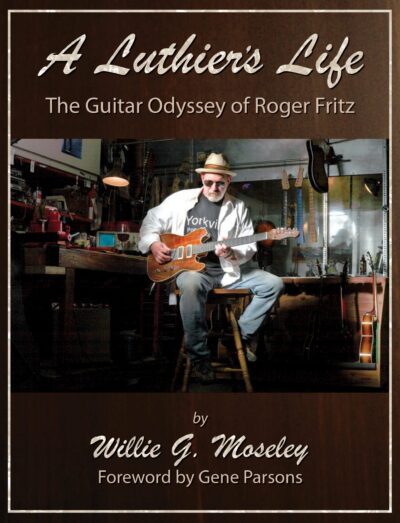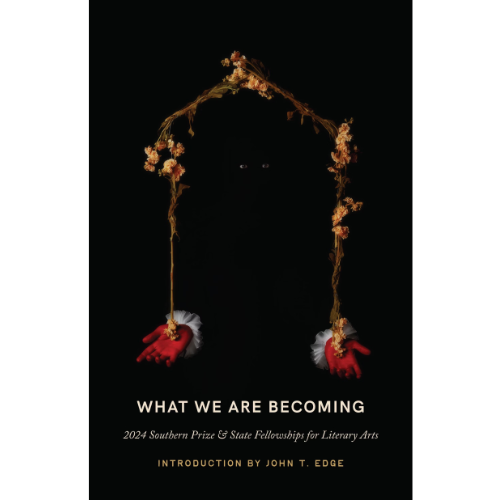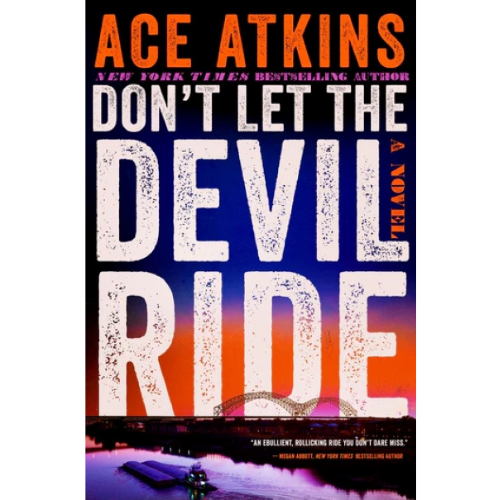A Luthier’s Life: The Guitar Odyssey of Roger Fritz
By Willie G. Moseley
Acclaim Press, 2023
Paper: $29.95
Genre: Music, Biography
Reviewed by Doug Simms
Willie Moseley’s (Senior Writer for Vintage Guitar Magazine) well-illustrated chronological review of Roger Fritz’s diverse life and accomplishments presents a dazzling matrix of opportunities fulfilled that could easily occupy several lifetimes. If you’ve ever wondered what it would be like to be a popular guitar tech/luthier and have a successful guitar company, it’s all here. Willie takes us from Roger’s early garage band days and plywood guitar builds to climbing the ladder as a sought-after guitar tech and builder. Along the way, we’re treated to deep dives into several of Roger’s major influences: guitar hero Roy Buchanan and the Kay guitar company.
It’s entertaining to review the sheer depth of Roger’s experience as a guitar tech, builder, and musician. I really like how Willie highlights Roger’s connections and how they weave a thread throughout his life, opening one opportunity after the other . It is also obvious that Roger had clarity and focus, keeping him in charge and on track of his personal family and professional goals.
Starting with Roger’s early days growing up in St. Louis, Mobile, and Birmingham, we learn of his early musical influences, including TV show guitarists (Micky Mouse Club, Adventures of Ozzie and Harriet), The Ventures, The Beatles, Elvis, B. B. King, and Freddie King. Willie points out how The Ventures were a major influence, particularly their Mosrite guitars, which planted the seeds of designing and building guitars in young Roger’s mind. Willie’s deep knowledge of Mosrite and other influential guitar companies of the day quickly becomes apparent.
Willie describes Roger’s move to Nashville in his mid-20s, where he made early connections with Nashville players and gained experience repairing and modifying guitars at Musicians Flea Market and running authorized warranty repair for Gibson at Rose Guitars. Getting to work on and build instruments for leading bands and musicians made Roger a mainstay in Nashville.
Roger also played in local bands, leading him to meet Marc Fisher, who had played in Roy Buchanan’s band. In 1986, Marc invited him to a Roy Buchanan show and introduced the two. Roger brought one of his Telecaster-style guitars that had active electronics to the meeting, which impressed Roy and ultimately led to him building Roy’s signature guitar, the Roy Buchanan Bluesmaster.
In 1987 Roger had moved back to Mobile and started Fritz Brothers Guitars with his brother, John, to produce Roy Buchanan Bluesmasters.
Willie provides a comprehensive mini-documentary on Roy Buchanan, including the 1971 PBS documentary “Introducing Roy Buchanan.” Roy’s career took off following the PBS special and Jeff Beck’s dedication of his famous “Cause We Ended as Lovers” to Roy. If you are a Roy Buchanan fan, you’ll like Willie’s retrospective stories and vignettes about Roy and his performances before his tragic death in August 1988 (the day after Roger received a thank-you note from George Harrison for giving him a Roy Buchanan Bluesmaster).
Thanks to the support of Roger and Roy’s friends, and George Harrison playing and promoting the Bluesmaster, Roger pressed on, customizing the Bluesmasters and putting them in the hands of well-known guitarists like Brad Whitfield (Aerosmith), Susanna Hoffs and Vicki Peterson (The Bangles), Gary Moore, Scotty Anderson, Tom Floyd, and Anson Funderburgh. Guitar nerds will enjoy reading about the various improvements, features, and new models Roger continued to produce.
Another major chapter in Roger’s life opened in 1993, when he was hired by Gibson CEO Henry Juszkiewicz to start a warranty, repair, and restoration department at Gibson in Nashville. Moving to Nashville required him to put Fritz Brothers on hold. Roger was very influential in consolidating Gibson’s guitar warranty repair program, including writing the Gibson warranty service manual. He set up the CNC machines for producing mandolins and dobros for Gibson’s newly acquired Original Musical Instruments (OMI). He also worked with Gibson’s Custom Shop and repaired guitars for Gibson endorsees and players like Slash, Ed King, and Les Paul.
Roger also began playing in local Nashville bands again, and worked with producer Bill Bottrell (Tom Petty, Sheryl Crow, Michael Jackson) to produce the Grammy-winning “This Is Shelby Lynn” album. Bill reintroduced Roger to Kay instruments with their 1950s K-162 short-scale bass, and this became the impetus for Roger’s decision to pursue Kay designs. The timing coincided with Gibson’s decision to shut down their OMI operation, and Roger decided to move to California in 2001 to continue working with producer Bill Bottrell. There he reactivated Fritz Brothers Guitars and built a prototype FB Bass based on the Kay K-162.
His work on Kay-inspired guitars got the attention of Tony Blair, Kay’s CEO, who asked Roger to come on board with Kay Vintage Reissue LLC in 2007 to produce reissues of their guitar catalog . Willie provides many historic details and photos for each model produced by Kay (and some “made for Sears” Silvertones), from early student models to the top-end Berney Kessell Jazz Special.
In 2013, Roger moved to Fairhope (Eastern Shore area of Mobile, AL) and reopened the Fritz Brothers guitar shop. This shop is open today, and you can learn more at fritzbrothersguitars.com.
This book appealed to me on multiple personal levels – I had been playing guitar for two years when I saw Roy Buchanan on the famous 1971 PBS special “Introducing Roy Buchanan,” impressing me with great skills and new techniques I had never seen or heard before. Kay guitars were inexpensive and available at the local Sears and Montgomery Ward stores in my hometown, and I often considered them desirable when looking for my first electric guitar. At various points in my life, I have considered building guitars with no appreciation for the experience, skills, and tools I would need, imagining I would soon be easily producing top-quality instruments in my garage without paying any dues. This book sure made it clear that that was not the way it happens!
Walking through Roger’s life, you wonder how any of this could have been predicted at any point and are left to appreciate Roger’s deep mix of skills, experience, relationships, and fateful meetings. And Roger seems to have remained in the driver’s seat throughout the journey.
As with his other guitar books, I’m convinced you’d be hard pressed to find a more entertaining and informed bio author than Willie Moseley. It takes a lot of experience and years of seeing, hearing, playing, and writing about thousands of guitars to string so many details and stories together. The hundreds of illustrations and guitar photos alone make this book a valuable resource.
Doug Simms is a guitarist and IT/website company owner in Prattville, AL. His hobbies include antique bottle collecting and playing guitar and bass. He’s especially fond of a 2014 Collings i35 Deluxe guitar and 1977 Alembic Series I bass and is working on his chops to deserve either of them.







Leave A Comment
You must be logged in to post a comment.